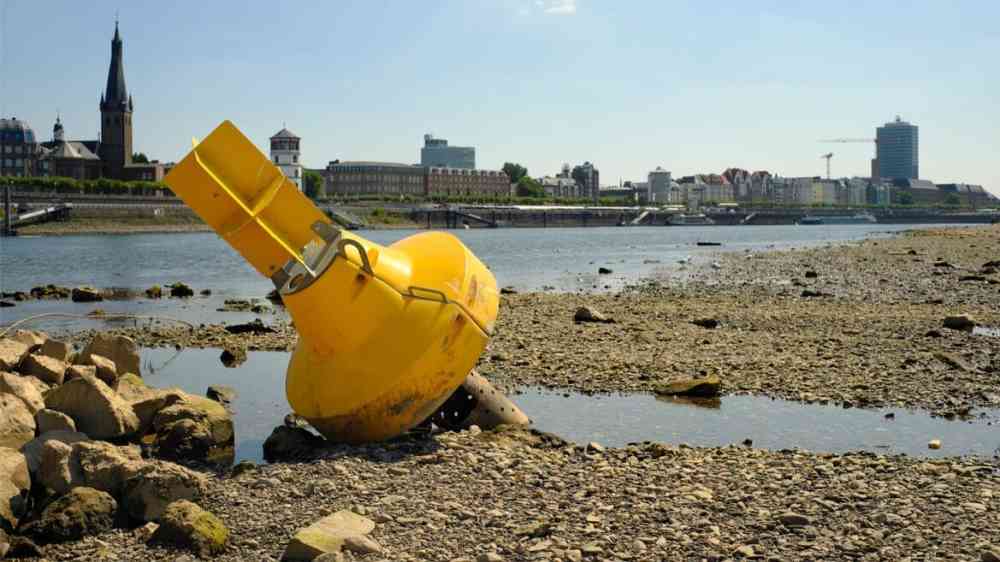The 2022 drought: What was the role of climate change?

The drought that lasted through the summer of 2022 was especially intense and caused the soil in many regions of Europe to dry out substantially. Public discussions about the causes repeatedly broached the question of the extent to which climate change intensified this extreme weather event. A research team coordinated by the Helmholtz Centre for Environmental Research (UFZ) has now discovered that more than 30 percent of the extraordinary intensity and physical extent of the drought can be attributed to human-induced climate change. As they write in an article for Nature Geoscience, this extreme event was exacerbated by the fact that climate change had already caused soil moisture levels to drop continuously over the previous years.
The extreme drought severely affected public life in many countries in Central and Southern Europe between June and August in the summer of 2022. For example, half the population in Italy faced water restrictions, while in France more than 100 municipalities were supplied with drinking water via trucks. In agriculture, grain maize, sunflower and soybean yields across Europe dropped by 15 percent compared to the average over 2017 to 2021. Severe forest fires raged in Italy, France, Slovenia and Romania, navigation was restricted on rivers such as the Po and Rhine and hydroelectric power plants produced less electric power due to the lower discharge. "The summer drought in 2022 had serious socio-economic consequences for Europe," says Dr Emanuele Bevacqua, lead author of the study and head of the UFZ working group Compound Climate Extremes.
The Intergovernmental Panel on Climate Change (IPCC) had already established that droughts are affected by human-induced climate change. However, our understanding of the contribution of climate change to individual drought events has been limited. To investigate water storage volumes in the soil and their geographical distribution as well as the discharge volumes of rivers in Europe, the researchers used observational data and the mHM hydrological model developed at the UFZ, which accounts for precipitation and temperature measurement data.
The researchers found that the deficit in simulated soil moisture in the top two meters of soil across central and southern Europe from June to August was roughly 280 cubic kilometres. This means that an estimated volume of water corresponding to 120 million swimming pools was missing from the ground. Furthermore, 1.64 million square kilometres were affected by drought between June and August. This is roughly 29 percent of the land area of Central and Southern Europe, a larger area than at any time since 1960. "Our simulations show that the 2022 drought was the most extreme since 1960," says Emanuele Bevacqua. The water available in the ground was at its lowest level since the start of satellite observations in 2002. The exceptional severity of the drought was primarily due to anomalous weather: Large parts of Europe experienced hardly any precipitation between March and August. Heat waves also contributed to an exceptionally warm summer. The average summer temperature in Central and Southern Europe was 1.9 degrees Celsius above the average between 1981 and 2010. "While the precipitation deficits were crucial contributing factors for the drought, the high temperatures intensified the decline in soil moisture and runoff volumes," says the UFZ researcher.
The research team also determined the contribution of human-induced climate change to the extreme drought in the summer of 2022. They did this by comparing soil moisture levels under the observed weather conditions and with those obtained by excluding the changes in precipitation and temperature due to climate change. The bottom line: Of the calculated soil moisture deficit of roughly 280 cubic kilometres in Central and Southern Europe, approximately 87 cubic kilometres, or about 31 percent, can be attributed to climate change. Climate change also had a significant influence on the spatial extent of the drought: Approximately 38 percent or 0.61 million square kilometres of area affected by the drought in Europe can be attributed to climate change. "Climate change has substantially intensified the drought. This can primarily be attributed to the higher temperatures, as these increase the evaporation rates," says Prof. Dr Jakob Zscheischler, co-author and head of the UFZ's Department of Compound Environmental Risks. Climate change also impacts the amount of water reaching the watercourses, thereby affecting navigability on the major rivers and the use of hydropower as an energy carrier. For example, climate change contributed to 19 percent of the area covered by dry rivers in Central and Southern Europe.
The researchers also more precisely classified the calculated contribution of climate change to the extreme drought in the summer of 2022. "Rising temperatures due to human-induced climate change are not a sudden event. They have been anchored in the system for a long time," explains UFZ climate scientist Jakob Zscheischler. For example, the 2021/2022 water management year began in November of 2021 with lower soil moisture/discharge levels that would not have occurred in the absence of anthropogenic climate change. The researchers have now been able to more precisely quantify this factor, the effect of which on the intensity of drought is manifested with a time lag. They calculated the contribution of climate change to the 2022 drought that was already "stored" in the system prior to 1st November 2021. Based on this calculation, this delayed effect contributed between 14 and 41 percent of the total climate change effect, depending on the specific hydrological model applied. "Climate change has already continuously contributed to higher temperatures and increased evaporation and soil dryout in recent years, and thus contributed significantly to the drought in the summer of 2022," says Jakob Zscheischler. And Emanuele Bevacqua adds: "Little attention has been given to date to the role of the delayed effects of climate change on droughts." This role is important, however, as the water needs of two thirds of the population of Europe, for example, are met by groundwater and groundwater is already overused in many cities.